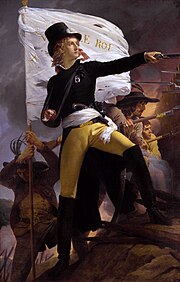| Henri du Vergier de la Rochejaquelein | |
|---|---|
 Henri de la Rochejaquelein by Pierre-Narcisse Guérin, c. 1816 | |
| Born | 30 August 1772 |
| Died | 28 January 1794 (aged 21) |
| Place of birth | Mauléon, Kingdom of France |
| Place of death | Nuaillé, French First Republic |
| Allegiance |
Royalist rebels |
| Service/branch | French Royal Army |
| Years of service | 1790–1794 |
| Rank | Generalissimo |
| Commands held | Catholic and Royal Army |
| Battles/wars |
Insurrection of 10 August 1792
|
Henri du Vergier, comte de la Rochejaquelein (August 30, 1772 – January 28, 1794[1]), was the youngest general of the Royalist Vendéan insurrection during the French Revolution.
Life[]
Early activities[]
Born in the Château de la Durbellière, Saint-Aubin-de-Baubigné, near Châtillon, La Rochejaquelein fought for the first time defending the Tuileries Palace on the 10th of August attack of 1792, as an officer of the Constitutional Guard of King Louis XVI.
Returned to his home province, he refused to apply for the levée en masse called by the outbreak of the French Revolutionary Wars, he joined his cousin Louis-Marie Joseph Lescure on the latter's estates in Poitou.
Rebellion[]
Soon after, they started fighting the troops of the French Republic with Maurice-Louis-Joseph Gigot d'Elbée and the Marquis de Bonchamps from April 1793. There, he gave famous order "Mes amis, si j'avance, suivez-moi! Si je recule, tuez-moi! Si je meurs, vengez-moi!" ("Friends, if I advance, follow me! If I retreat, kill me! If I die, avenge me!").
Leading a few thousands Vendéan peasants, La Rochejaquelein gained his first victory over the French Revolutionary Army on April 13, took part to the taking of Bressuire on May 3, of Fontenay-le-Comte on the 25th, and of Saumur on June 9.
In August, in Luçon, he regrouped the Vendéan army, which was on the verge of being disbanded, and won the battle of Chantonnay in September. He had to retreat across the Loire after being beaten in Cholet, on October 17.
Final months[]

The Death of Henri de La Rochejaquelein, painting by Alexandre Bloch
On October 20, La Rochejaquelein was elected commander-in-chief of the Royal and Catholic Armies, replacing d'Elbée - who had been severely wounded in Cholet. However, his bravery did not compensate for his lack of experience and strategic skills. He marched onto Granville, took Avranches on November 12, but failed to seize Granville and retreated to Angers in order to cross the Loire.
François Séverin Marceau, Jean Baptiste Kléber and François Joseph Westermann gave chase, defeating him once in Le Mans on December 12, and again, more severely, on the 23rd of December in Savenay. He managed to save the remains of his army by crossing the Loire, and left under the criticism of his fellow companions.
While trying to pursue a guerilla war against the Republicans, he was killed by a Republican soldier near Nuaillé. He was twenty-two years old. His brother Louis became the head of the royalists in Vendée in 1813 and furthered the royalist cause there during the Hundred Days period. He fell in battle at Pont-de-Mathis on 4 June 1815.[2]
Notes[]
- ↑ George J. Hill, The Story of the War in La Vendée and the Little Chouannerie (New York: D. & J. Sadlier & Co. n.d.), pp. 154-155. [1]
- ↑ Chambers's encyclopaedia
References[]
This article incorporates text from a publication now in the public domain: Chisholm, Hugh, ed. Encyclopædia Britannica Cambridge University Press
External links[]
The original article can be found at Henri de la Rochejaquelein and the edit history here.